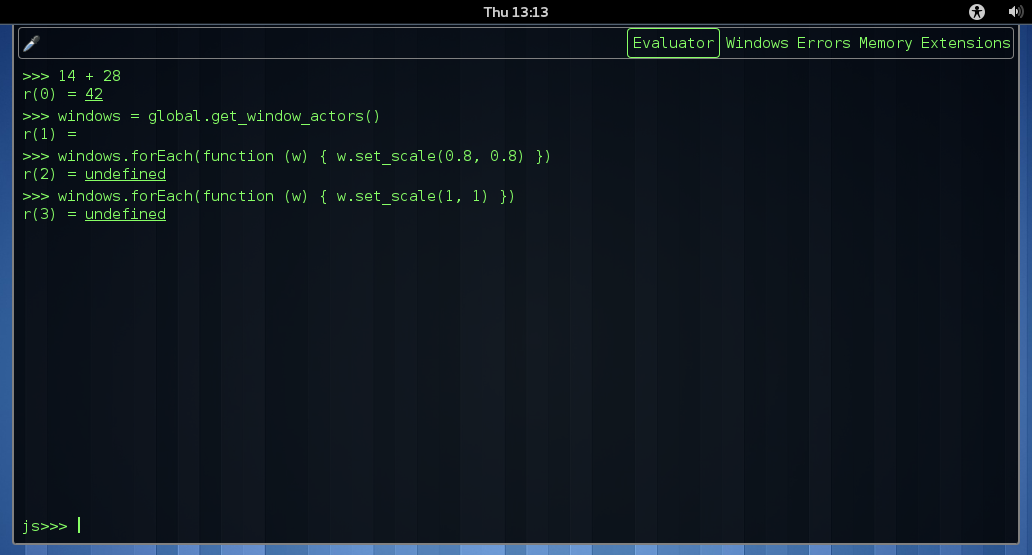GNOME 3 Cheat Sheet
Contents
GNOME 3 contains many new features, including tricks and advanced functionality. This guide is an introduction to some of these shortcuts, and will help you to get the most from GNOME 3. It has been written in reference to GNOME version 3.6.
Many of these tips use the Super key. On a standard PC keyboard, this is marked with the Windows logo.
Resizing Windows
Windows can be maximized, unmaximized and snapped to one side of the screen by dragging the window titlebar.
Action |
Titlebar Drag |
Keyboard Shortcut |
Maximize |
To the top of the screen |
Super+Up |
Unmaximize |
Down |
Super+Down |
Fill half the screen |
To the side of the screen |
Super+Left/Right Arrow |
If the titlebar is hidden when a window is maximized, you can drag the toolbar instead. Windows can be dragged anywhere, by holding the Super key while clicking.
Two windows snapped to half the screen:
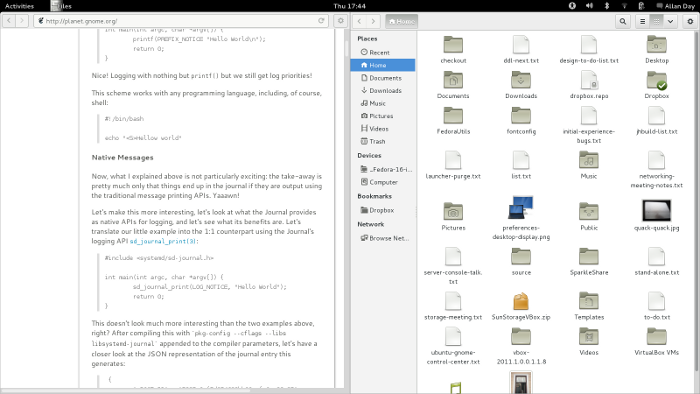
Application Switcher
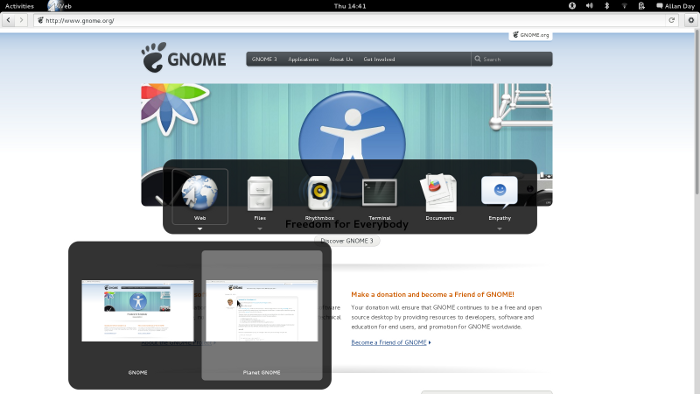
Use Alt+Tab to switch between applications.
Alt+<key above tab> (often marked with `) switches through the windows of the current application.
- You can use the mouse to click on the application or window that you want.
You can also navigate the Application Switcher using the arrow keys.
Activities Overview

The Activities Overview allows you to launch new applications, switch windows, and move windows between workspaces.
There are three ways to open the Activities Overview:
Click on Activities in the top bar
- Use the hot corner in the top-left corner of the screen
Press the Super key
Exit the Activities Overview by selecting a window, application or workspace, or by pressing the Super or Esc key.
Search

Searching from the Activities Overview is one of the most powerful GNOME 3 features. It can be used to launch applications, switch windows, and find search results from different applications, like Documents, Files and Contacts.
To search:
Press the Super key to open the Activities Overview
- Type your search
Press Return to select the top search result, or use the arrow keys or the mouse to select from the results
Launching Applications
To launch an application:
Click on the application launcher in the Dash (this is on the left-hand side in the Activities Overview.
- More applications can be accessed by clicking on the applications button, which is marked with a grid icon.
There are some tricks that you can use when launching an application:
Hold the Ctrl key and click on an application icon to launch a new window
- Middle click on an application to launch in a new workspace
- Right click on the application to access a context menu, with options for selecting a specific window or opening a new one
Adding & Removing Favorites
To add an application to the Dash:
- Select the grid button to view all your applications.
Drag the application launcher to the Dash
To remove a favourite, drag it from the Dash to the grid button.

Workspaces
Workspaces allow you to group windows together. To create a new workspace:
Enter the Activities Overview
- Drag a window to the workspace switcher at the right-hand side of the screen
To change workspace:
Open the Activities Overview and select a workspace from the right-hand side
- Or use a keyboard shortcut:
Ctrl+Alt+Up - switch to the workspace above
Ctrl+Alt+Down - switch to the workspace below
Notifications & Message Tray
Notifications are displayed as banners at the bottom of the screen.

To see more details about a notification, or to act on it, hover the pointer over the banner. You can use this feature to quickly respond to chat messages.

The Message Tray contains missed notifications and ongoing activities, like chat conversations, playing music and file transfers.
To open the Message Tray:
- Hold the mouse pointer over the bottom screen edge, or
Use the Super+M key combination, or
Open the Activities Overview

In the tray, you can dismiss notifications, send messages to chat conversations, pause or skip music playback, and so on.
To exit the Message Tray, press the Esc key or click in the area above the tray itself.
Developer tools
Looking Glass is GNOME Shell's integrated inspector tool and JavaScript console useful for debugging. It can be run by typing 'lg' in the Alt+F2 prompt and can then be exited by pressing Esc. More details are here.
Typing 'r' or 'restart' in the Alt+F2 prompt will restart GNOME Shell. This is useful when you are make changes to the GNOME Shell code while working within the GNOME Shell. You don't need to compile anything if you only changed JavaScript code, but you need to run compilation as you would normally do for C code before restarting.
Typing 'rt' in the Alt+F2 prompt will reload the GNOME Shell theme. This is useful when you are a theme designer and want to test changes in your theme without restarting the whole shell. The theme file is share/gnome-shell/theme/gnome-shell.css.
Typing 'debugexit' in the Alt+F2 prompt will quit GNOME Shell. This is generally only useful when you are running a development version of GNOME Shell which you started from the command line; in a normal GNOME 3 session, gnome-session will just restart GNOME Shell if you exit it.
Applications
Applications in GNOME 3 have some new features, including some handy tricks.
Search
Many GNOME 3 applications allow you to search simply by typing, including Files, Contacts and Documents. Just start typing to search.
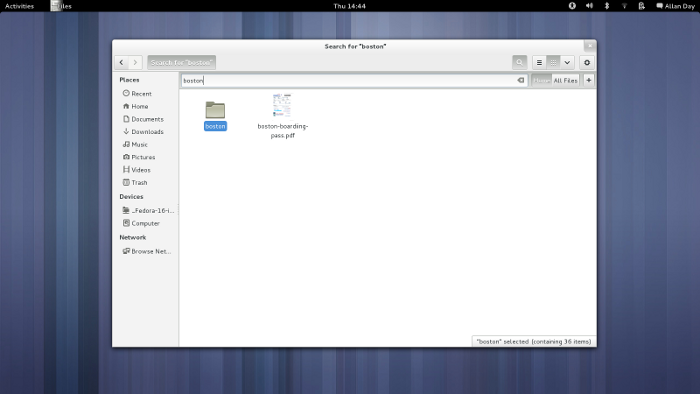
Application Menus
Each GNOME application has an application menu in the black top bar, where it says the application's name. This menu always includes the Quit menu item. For many GNOME 3 application, these application menus also provide application-wide options and actions, such as Preferences and Help.
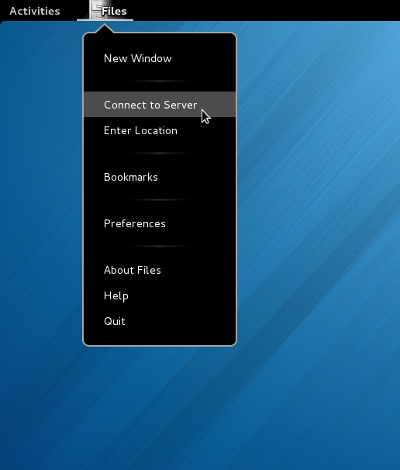
The application menu can also be opened with the Super+F10 keyboard shortcut.
Hidden titlebars
To save space on small screens, and to avoid distraction, many GNOME applications hide their titlebar when maximized. Such titlebar-less maximized windows can be dragged by clicking on empty space in the applications menubar or toolbar, or by starting a drag in the top bar.
Invisible borders
GNOME sports very clean-looking, thin window decorations. Nevertheless, windows can still be easily resized by starting a drag close to the window edge, on what is called the windows invisible border. The area in which this is possible roughly correlated to the shadow that is drawn around the window.
System Settings
System Settings are available from the user menu in the top right corner. You can go here to personalize your system with a custom background, choose the display language and keyboard layout, configure devices like printers and Wacom panels, or create new user accounts.
- Tip: Each status menu has a direct link to the relevant system settings as the last menu item.
Customization
GNOME Tweak Tool is a new application that contains a variety of customization options beyond what's available in the System Settings. It can be installed through your distribution.
Notable options include:
- Change the visual theme to always give applications a dark appearance
- Use static workspaces
- Extend the current workspace to fill multiple monitors
- Fine-grained keyboard layout configuration
GNOME 3 running in dark mode:

Screenshots & Screen Recording
Screenshots
The PrintScn key will take a screenshot, and will automatically save the image in your Pictures folder. There are some other handy shortcuts that you can use here:
Alt+PrintScn - take a screenshot of the current window only
Shift+PrintScn - select a specific area of the screen
Ctrl+PrintScn - save the screenshot to the clipboard
These keyboard shortcuts can be combined. For example: Alt+Ctrl+PrintScn will save a screenshot of the current window to the clipboard.
Screen Recording
GNOME 3 comes with a built-in screen recorder. This can be activated using the Shift+Ctrl+Alt+r keyboard shortcut. A red circle is displayed in the bottom-right hand corner of the screen while recording is taking place.

